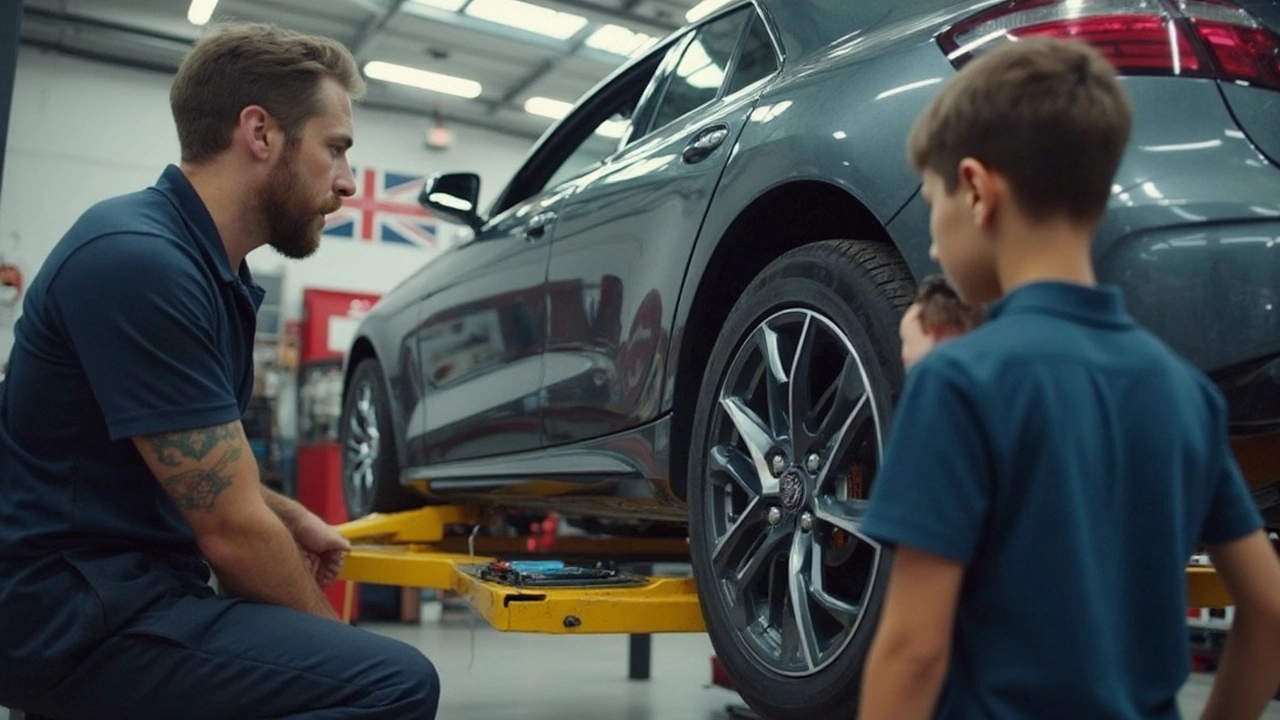Ever swapped to alloy wheels and wondered if that means more trips to the shop for alignment? Plenty of people think alignment is just about the tires or maybe the car’s suspension, but the truth is, your wheels—especially alloys—play a key part. Alignment isn’t about the wheel material itself, it’s about the angles your wheels sit at so your car drives straight and your tires wear evenly. But here’s the thing: if your fancy alloys take a hit on a curb or a nasty pothole, they can bend, and that throws everything off.
Ignoring alignment just because you upgraded to alloys? Bad move. Doesn’t matter if your wheels are steel or aluminum alloys—if your car pulls to one side, your steering wheel shakes, or your tires look weirdly worn on the edges, something’s up. Alloy wheels can actually magnify alignment problems because they’re lighter and can bend more easily under impact than old-school steel rims. Fixing your alignment after an upgrade or a big bump isn’t just about smooth driving; skip it, and you’ll chew through tires faster, waste gas, and maybe even push parts of your suspension to the breaking point.
- What Is Wheel Alignment And Does Alloy Matter?
- Signs Your Alloy Wheels Need Alignment
- Risks Of Ignoring Misalignment
- How To Keep Your Alloy Wheels Aligned
What Is Wheel Alignment And Does Alloy Matter?
Wheel alignment is all about making sure your car’s wheels are set to the exact angles recommended by your manufacturer. These angles—called toe, camber, and caster—keep everything pointing in the right direction and stop your car from drifting or chewing up tires too fast. When these angles get out of whack, your ride doesn't just get bumpy—it gets costly.
You might think putting on alloy wheels changes everything, but here’s the deal: alignment checks stay important no matter what your wheels are made of. Upgrading to alloys doesn’t mean your car “forgets” about alignment. In fact, because alloys are often lighter and sometimes a bit softer than steel, they can get knocked out of shape just from daily driving or a sudden curb.
“Your wheels and suspension work as a team. Even if you upgrade your wheels, wheel alignment should never be skipped or delayed,” recommends Tom Burke, lead technician at Car Care Australia.
The basics come down to these:
- Toe: How much your wheels angle inward or outward when looked at from above.
- Camber: How much your wheels tilt in or out when seen from the front.
- Caster: The tilt of your steering axis, which can affect stability and steering feel.
If these aren't set just right, you're headed for trouble—plenty of tire shops have seen people run through a set of brand-new tires way quicker than they should, just because an alignment got skipped.
| Proper Alignment (average car) | Misalignment Causes |
|---|---|
| Tires last 40,000+ km | Premature tire wear |
| Straight-line driving | Car pulls left/right |
| Smooth steering | Shaky or loose steering |
Switching to alloy wheels might not change the alignment
Signs Your Alloy Wheels Need Alignment
Alignment issues can sneak up on you. There’s no blinking light for this on your dash, and a lot of drivers miss the signs until their tires are shot. But if you’re paying attention, a few clear clues shout that your wheel alignment is off, especially with alloy wheels. These problems mess with your ride quality and end up costing you.
- Your car pulls to one side: If you’ve got to keep steering a little to drive straight, something’s up. This is probably the biggest giveaway. Perfect alignment means you can let go of the wheel (on a safe, flat road!) and your car tracks straight.
- Steering wheel isn’t level: Got your badge tilted to the left or right while driving straight? That’s a dead-simple clue your alignment is out of whack.
- Uneven tire wear: Take a good look at your tires. Are the inside or outside edges wearing down way faster than the rest? New tires can start looking old fast if the wheels are pointing the wrong direction.
- Vibrations in the steering wheel: You shouldn’t feel shaking hands at highway speeds. Alloys can bend easier than steel, so hits from potholes or curbs often mean you’ll feel more shaking if alignment’s bad.
- Loose or sloppy handling: Does your car feel weird whenever you take a bend, sort of floaty or like you need to constantly correct the wheel? Big sign of bad alignment.
If you’ve got alloys and you drive on rough roads or recently hit a deep pothole, you should be on the lookout. Studies on urban driving found that misalignment is behind about 60% of premature tire edge wear in city cars. Plus, data from tire shops show that most alignment checks after hitting a curb catch issues before the owner even notices performance changes.
| Sign | What to Look For | Potential Damage |
|---|---|---|
| Pulling to one side | Car veers if you loosen grip | Rapid tire wear, stress on steering parts |
| Uneven tire wear | Edges bald, center good | Shortened tire life, poor traction |
| Shaking steering wheel | Vibration starts above 40 mph | Potential structural wheel/suspension issues |
| Off-center steering wheel | Logo isn’t straight, even on straight roads | Misalignment, annoying driving experience |
Catching these issues early with alloys is key. You’ll save money, and your car will just feel better to drive.

Risks Of Ignoring Misalignment
Let’s get real about what happens if you brush off alignment problems, especially when rolling on alloy wheels. The biggest hit is to your wallet. If your wheels are off, your tires will wear down faster on the edges or in weird patterns—this means buying new tires much sooner than normal. On average, misalignment can shave 30% or more off your tire life. That’s like tossing a third of your tire money straight into the trash.
If you’re noticing your steering wheel pulling, little shakes, or even just a rougher ride, you’re also putting your car’s handling and safety on the line. A misaligned setup can make your car feel loose around corners or slippery on wet roads. For folks using alloy wheels, this is even more important. Because alloys bend easier than steel, a knocked wheel can send your alignment out of whack faster and more often.
Fuel economy’s the other major loss. Misaligned wheels cause extra rolling resistance, making your car work harder. It’s not a huge bump per tank, but over thousands of kilometers, all that wasted gas adds up. And don’t forget your suspension—if your car is constantly fighting misaligned wheels, parts like ball joints and bushings wear out fast, inviting even more repairs.
| Problem | What You Lose |
|---|---|
| Premature Tire Wear | Lose up to 30% of tire life |
| Worse Fuel Economy | 2-10% more fuel used |
| Poor Handling | Less safe steering |
| Extra Suspension Wear | Expensive repairs later |
Here’s a quick checklist of what can go wrong if you ignore alignment with alloy wheels:
- Weird, uneven tire wear (hello, early replacements)
- Your ride feels sloppy, especially at higher speeds
- Tires screech or thump more—don’t ignore those sounds
- Suspension repairs rack up
- Worse mileage over time
The bottom line: Don’t gamble with alloy wheels or your car’s safety. Regular alignment is cheaper than a new set of tires or a busted suspension, and it keeps you in control out on the road.
How To Keep Your Alloy Wheels Aligned
Alloy wheels look sharp, but they need some basic care to stay in top shape. Alignment matters for every car, but the lighter build of alloys means you can actually feel problems sooner than with heavy steel ones. Keep things dialed in with a few simple habits.
- Alignment checks matter: Get your wheels checked every 10,000 miles or at least once a year—whichever comes first. If you drive on rough roads, had a close encounter with a pothole, or just switched to alloys, do it sooner.
- Keep tire pressure spot on: Wrong pressure throws off alignment. Check your tire pressure at least once a month, especially after big temperature swings.
- Balance tires when you rotate: Ask for balancing every time you rotate your tires (usually every 5,000-7,000 miles). Unbalanced tires shake and can nudge wheels out of alignment faster.
- Avoid curb rashes and deep potholes: Sounds obvious, but most bent alloy rims start from a single little mishap at low speed. Watch those parking maneuvers—teach your kids to, too—I learned that the hard way with Troy behind the wheel.
If you feel steering pull, weird tire wear, or you recently swapped wheels, book an alignment alongside your regular service. Here’s a table with real costs and stats to show why staying on top of this makes sense:
| Service | Average Cost (USD) | Recommended Interval |
|---|---|---|
| Wheel Alignment | $75 - $150 | Every 10,000 miles |
| Tire Replacement (set of 4) | $400 - $1,000+ | Every 40,000-60,000 miles with proper care |
| Bent Alloy Rim Repair | $75 - $150 per wheel | As needed |
Skipping alignment means you can burn through a set of tires in half the time, which hits your wallet hard. Stay regular on these checks and your alloy wheels will run straighter and keep your car cruising smoothly, with no extra drama or surprise repairs.




